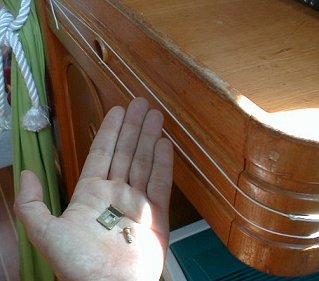

We were very pleased to be across the Atlantic at journey's end with so much that had worked perfectly and with a boat that had carried us safely and surely. However, we had amassed a new 'To Do' list which took up most of a side of A4 paper. Some of the items were trivial, but actually, when you are totally dependent on your craft in the middle of an ocean too rough to permit any but the simplest maintenance, even some of the trivia can become quite a problem. I am including some details here as they may apply to others fitting out for such a journey. I hope other readers will find this interesting to as a brief insight into what goes on in a small yacht, as well as in the mariner's mind.
 |
| Incessant rolling dislodged this locker catch from the wood. Reinforcement will be necessary here |
Now this sounds like real trivia, but it was not. After a week or so of incessant rolling our two-and-a-half-inch (65 mm) high collection of neatly folded British Admiralty sea-charts had organised themselves into a solid block, not their usual random, splayed heap in the chart locker. This solid mass of high quality wood-pulp then continued to slide back and forth across the locker, each time hitting the door with all the force of a decent lump hammer. A few days later, the hole in the plywood that held the single screw of the catch-plate gave way and the door was open.
The charts would soon be all over the floor, so we lashed it shut. What you see in the photo is our dainty, at-anchor replacement of the original lashing which was a much stronger, bolder affair involving lots of 6 mm cord. It held, but I still have not thought of a really good reinforcement to ensure that this doesn't happen again.
Our gas cooker, like most aboard open-sea craft, is gimballed. This means that the whole two-burner, grill and oven affair is suspended from two stainless steel brackets. These were screwed to the plywood of the boat with ordinary wood-screws, but I decided some years ago to improve this by through-bolting the mountings with M5 studding.
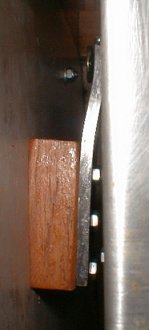 |
| Incessant rolling began to dislodge the cooker too. Reinforcement has been necessary here as well. |
These gimbals worked hard during this crossing, the cooker swinging 20, 30 or even 40° either side of the vertical every few seconds for the whole trip. Several times it hit its end-stops, either the woodwork behind or the 'crash-bar' in front of the stove. It was not until we were a week away from Barbados that the nuts on one side began to work loose enough to fall off altogether. We locked the cooker in place and had to rely on the fiddles to keep pans, the kettle and the ashtray (!) in place in the hobs.
The reason for this is that it is impossible to tighten ordinary nuts and bolts hard enough against wood for them to lock in place. You must use either
There was not enough room in this installation for either of the first two options so I have now rebolted the whole thing with 3 x 1 inch (75 x 25 mm) stainless steel backing plates.
As mentioned in the previous page, we were for a time using a radio-cassette machine to record French weather forecasts from the short-wave radio and translate the French by re-winding the tape to get the finer points onto paper. Normally this radio is only used for mild entertainment purposes at anchor or in port. It has always been kept lashed into the quarter-berth out of everyone's way. This position was not the best for a boisterous ocean crossing, it soon caught a direct hit from a pint of sea-water coming in the main hatch. It did not work again during the crossing.
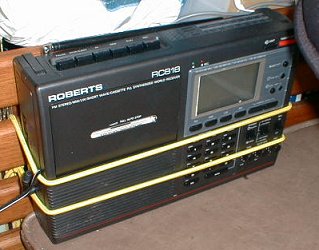 |
| Sea water in the works of this excellent radio-cassette machine stopped it working entirely, until I gave it a good wash in fresh water. |
Luckily, with access to amateur radio, these French forecasts were not our only source of good weather information. Trudi, 8P6QM, was able to relay to us on 21.400 MHz forecasts created by George, KP2G, and discussed with her a few hours earlier on 7.086 MHz, until we were within a few hundred miles and could talk to George directly. This was marvellous, but it did not take a hugely detailed knowledge of radio theory to know how to fix the problem once the anchor was down.
Believe it or not, all electronic circuits are completely waterproof. It is the conductivity of water, especially sea-water, sitting across the connections that makes them malfunction. The corrosive powers of sea-water can also do terrible damage if left in place for more than a few days. I took the plastic case off the machine off and ended up with three circuit boards (a computer, the radio receiver and the cassette machine), a buzzer and the loudspeaker, all interconnected and sitting in the washing-up bowl. I washed and re-washed the whole lot in several changes of cold, fresh water, washed and oiled the telescopic antenna and the battery terminals, and rinsed out the two halves of the plastic case. When I was convinced that there were no more salt crystals lurking anywhere, I put all the parts around the cockpit seats in the sun and carefully began to dry everything with clean, absorbent kitchen paper. When reassembled and then left overnight to dry completely, it all worked again perfectly.
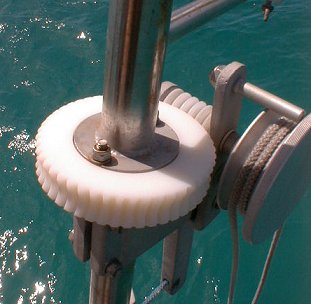 |
| During gale-force squalls these gears managed to slip. Every tooth on the worm-wheel represents 7.5° of course-change and we sometimes ended up as far as 30° off course. |
This seems very bold at the time, 'Electicity and water don't mix' we are told. I have done this to many pieces of sensitive electronics including Autohelm autopilots, digital watches and cameras. It usually works, if the corrosion has not gone too far and if you are careful not to touch any of the delicate adjustments. All you have to do is remember how to put it all back together again when it's dry!
Nothing was damaged here but this is a problem I must fix. When the wind gusted into gale force 8 (over about 35 knots) somehow or other the spring which holds this worm-gear to the bigger worm-wheel managed to let it slip around, tooth at a time. We ended up sometimes with the wind on our beam until I went outside and reset these gears to put it back behind us. I am imagining two or three turns of 6 mm (quarter-inch) bungee elastic around the top of the worm's lever, holding it toward the main shaft and increasing the pressure on the gear-teeth. We do not want this happening if we were caught in a prolonged gale.
Now here is a real mystery. We left Tenerife with a lovely high barometer reading of 1020 hPa. Within two days this had dropped to 1012 hPa and a fortnight later we were logging 999 to 1002 hPa. All the available information says that barometer readings as low as this only occur here when hurricane activity is imminent. We checked this with other boats and with Trudi during the crossing and we all came to the conclusion that our barometer had suffered the same kind of water damage as the radio-cassette. Looking at the corrosion newly evident on the brass case, I was happy to believe them.
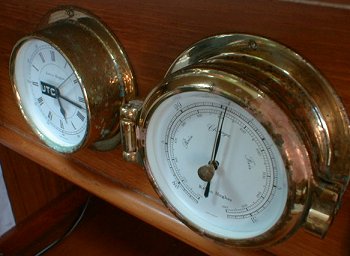 |
| Our clock and barometer, above the chart-table, both showing external signs of sea-water damage from the open hatch, but both, apparently, in good condition inside. |
I have since taken the instrument to pieces, ready to immerse it in a sink-full of fresh water, and it was in perfect condition inside with no hint of water ingress. I put it all back together and called Bridgetown Port Control on the ship-to-shore VHF. He happily confirmed the current pressure was 1000 hPa. This was exactly what our thing was reading in the first place that day! Is it correct? Is all the literature wrong? Is it a temperature effect on ours and Bridgetown port's aneroid mechanism? I can't keep calling him about it, I'll wait until we get to a different port and try to get a decent calibration reading for it.
We had had some problems with lack of electrical power on the way to Tenerife, so while we were there I decided to spend some more money we didn't have and invest in a towed generator. We chose the Aqua4gen from the UK mail-order company, Nautical World as this was supposed to deliver 8 amps at six knots rather than the 5 amps promised by the alternative, the Aquair 100. We looked forward to being able to run the fridge and the radar continuously once we got into the trade-winds...
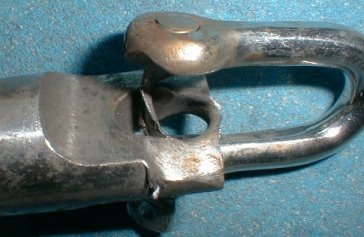 |
| After 19 days' continuous use, and 1757 miles logged, this was the state of the coupling between the Aqua4gen shaft and its drive-line. We did the next 1026 miles with it all coiled up in the cockpit. Not good value for money! |
The thing worked alright, but only just allowed us to be able to run essential electrics like lights and radios. It was better than nothing but nowhere near as good as the advertising led us to believe. (Note: this was in addition to our two large solar panels which more than keep us happy in port). This seemed to be related to the fact that the towed turbine, heavy as it was, surfaced in the trough as we rounded the crest of every following sea thus denying us the surge of power that this should have produced. This also allowed the tow-line to untwist in the air so that it needed most of the time until the next wave came to twist up enough to deliver torque again to the generator hanging on our pushpit.
After just over two weeks I noticed that the white case of the machine on the rail was beginning to look very dirty with a kind of black dust gathering on it. In order to stop the spinning and have a look at the universal joint on the shaft of the generator I had to reach out and grip it in my hand. Once I plucked up the courage to do this - the forces were not too strong and it didn't in fact hurt - I was amazed at the extent of the wear in the stainless steel.
What had been a brand new shackle fitting nicely through a nylon bush in the end of the main shaft had been reduced to the mess shown in the photograph. Less than a millimetre of metal remained before the turbine and its line were to be lost in the deep for good. The remains of the nylon bush must have fallen into the sea around the time that the black metal-dust began appearing all over the outer casing. I pulled it all into the cockpit and, lacking any spares we had to do without the benefit of this £400-worth for the rest of the trip.
The people at LVM, who made it, tell me that they have since changed the design to include a longer tow-rope to keep it in the water more of the time (the Nautical World catalogue tells you you must not lengthen the line as this surfacing is a safety feature to prevent overheating!) and they have replaced the nylon bush with a bronze one. I wish they had told me about these changes before they took my money for the old design. Spare parts, free of charge, are, I am told, on their way to me, so I had better not say too much...
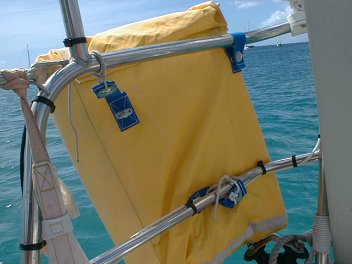 |
| The lifesling bag on the pushpit began to fall to bits too, however it was ten years old so I can almost forgive it |
Eagle-eyed observation of some of the photos taken looking aft from our hatch during in the trip will tell you that the lifesling and the horseshoe buoy on our pushpit also caused us problems. One night Nicky woke me with quite a panic in her voice asking me to have a look outside. Brilliant white flashes were coming from the sea beneath our transom! It turned out that the horseshoe man-overboard buoy had been washed from its mounting and was trailing behind us by its attached whistle on a line! The flashing light had correctly activated in the water and was giving us this unexpected display. It was easy enough to re-stow all of this in the forepeak for the rest of the trip.
The Lifesling, another man-overboard contraption, fell to bits more quietly, but the combination of corrosion and wear on its bag mountings will need a bit of modification and reinforcement with sail-needle and palm before our next major crossings.
 |
| Our jib furling line was badly frayed by the works of the Rotostay II roller furling drum. But look at that beautiful skyline in the background of the shot. This is more than enough worry and complaining for one day! |
They tell you you should walk right around the deck every day on passage to check for wear and chafe in your gear. I did not do this, it would have been too dangerous to risk with those boarding seas and very little chance of turning the boat around if I did go over the side. The wear in the Aqua4gen was invisible while it was spinning anyway, but the other thing wearing out was completely hidden until we began to roll up the jib to slow down on our final approach to the island.
The original furling line had served, like most of the rest of the running and standing rigging aboard, for the full ten years life-span of the boat. It looked a bit worn all along its length so I replaced it in Tenerife for this passage. The new rope will need replacing before we leave here.
The frayed part you see in the picture was the last turn on the furling drum during the passage. Somehow it had worked its way into the crack between the outer foil around the drum and the drum itself and worn and frayed away with every wind-shift. Much more wear and we may not have been able to roll up the sail at all. It was a good job it was only a small sail, but we could have been hit by such a gale that we really wanted it to roll away on demand. That would have been no time for the furling line to part on us!